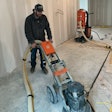

Something has gone wrong with one of your recent installations, and the customer is in your face and letting you have it. The flooring in her home is a different shade than what she ordered, or the finish is peeling, or the boards are cupping. She may be raising her voice or issuing veiled threats. In the face of this verbal onslaught, you're trying to compose a response while keeping your emotions in check. If you've encountered this situation before, you know how tough it can be, but handling it effectively is easier than you think — if you develop anger-response skills. Here's a step-by-step guide:
THE BEGINNING (30 SECONDS)
First and foremost, listen —immediately. No delays. As you listen, remember the triggers that can deepen a customer's anger: a seemingly uncaring attitude, argumentation or officious behavior. (See "Anger Triggers: What Sets Customers Off.")
As you size up the offended customer, gauge his emotional type: Is he a methodical inquisitor? An avenger? A bureaucrat anxious to catch someone breaking the rules? A righteous victim? Understand the customer's emotional type, and you'll be able to gear your conversation accordingly.
As the customer speaks, listen with your entire body. Arch forward a bit, keep your head erect, gaze at the customer and nod as he emphasizes key points.
At the same time, guard against displays of emotion on your part, however upset or angry you may be feeling. If you should find yourself becoming defensive or angry, count to 10 (yes, this technique really does work) or breathe deeply for a few seconds.
After the customer gets the conversation going, signal your willingness to continue: Invite him to sit down, step over to a more private location or enter your office. This simple action on your part symbolizes your interest in the customer— and sets the tone for a productive resolution of the problem.
THE CONVERSATION (2 TO 10 MINUTES)
Allow your customer to blow off steam if she must. Early in the conversation, let her know that you take all complaints very seriously and that you're seeking a resolution to the problem. But don't promise anything at this point. Picture yourself as an impartial observer. Let your customer know that your immediate goal is to understand the problem, as well as the circumstances that caused it, and then work with the customer to address it.
Continue to listen carefully as you walk through the problem with your customer. When you must answer a question or respond to a comment, speak slowly and thoughtfully. If the customer raises her voice, nod and make a notation on your notepad; this is an expression of your attentiveness. If your customer's anger persists, offer a subtle reaction to her outbursts — say, by moving your head back slightly whenever one occurs.
Remember the customer's emotional profile? Now is the time to use that knowledge. If the customer is angry that the floor wasn't installed exactly the way she expected, for instance, you might explore your installation procedures. If the customer feels her wishes were not taken seriously, you might affirm her. Model your communication style in response to the customer.
While you must continue to actively listen, you can relax your body somewhat during this phase of the conversation. Here, you may put the customer at ease for the first time. Continue to acknowledge the legitimacy of her emotions and offer anecdotes about problems you've encountered in the past with other home-improvement contractors. Move physically closer to the customer when she relaxes a bit.
And if you can, ascertain why the customer is bothered by the problem. A customer who encountered an installation delay, for instance, might not be angry about the late installation, but about having to change her plans as the result of the delay.
ATTACKING THE PROBLEM (2 TO 10 MINUTES)
Up to this point you've made no promises to the customer. In fact, you may not have said much, preferring instead to let the customer speak. Apologize, if that's appropriate. Outline in general terms how you'll go about resolving the problem. If you can give specifics — such as offering to resand and refinish the floor, replace the unacceptable boards or make an adjustment on the customer's account, do so. However, be sure to underpromise rather than overpromise.
It's more likely that you can't resolve the problem on the spot, but you can indicate your next step, such as visiting the home to inspect the floor, for example, or writing a letter to a manufacturer.
If possible, give the customer options — two or three ways you can address the problem. To most customers, options symbolize power. Or if you're in a position to resolve problems without having to consult someone else, simply ask: "What can I do to make things right?" While you might not be able to meet the customer's exact terms, those few words can begin a fruitful negotiation.
If you find yourself unable to resolve the problem to the customer's satisfaction, you might suggest potentially extreme solutions: dismissing an employee, shutting the entire business down for a few hours or dropping an entire product line. These suggestions, if presented properly, sound so extreme that even diehard complainers wouldn't advocate them.
A word of inspiration: This stage of discussion is often frustrating and aggravating, but think of it is an opportunity to sell your responsiveness. If you can make a "sale" here, you may end up with a grateful customer for years to come.
AFFIRMING THE BOND (30 TO 60 SECONDS)
The close of your conversation is an opportunity for you to thank your customer for bringing the problem to your attention. It's an opportunity, too, for you to reaffirm the customer seller bond. A handshake, a small gift, or an invitation to call back anytime works wonders.
HOW DID YOU DO? (1 TO 2 MINUTES)
After the customer leaves, take a minute or two to reflect on what you did right and what you did wrong during the encounter. Did you identify the problem quickly? Establish rapport with your customer? Did you meet your own complaint-resolution standards?
After assessing your own performance, make a note in your calendar to call or write the customer in another day or two. And note, also, any action you must take to meet promises you made to the customer.
Confronting and addressing customer anger, remember, is a skill. Like any skill, you can improve your efforts with practice. Look upon encounters with angry customers not as occasions to be feared, but as opportunities to improve your skills and demonstrate to your customers that you're really as responsive as you claim to be.
Richard Ensman is a free-lance writer who specializes in business-management topics.
GREAT EXPECTATIONS
One of the leading causes of customer anger is a wood floor that does not live up to expectations. A faulty installation is sometimes responsible, but more often the culprit is an unreasonable set of expectations on the part of the customer. You can head that off by educating the customer about wood flooring, making sure his or her expectations are reasonable. Here’s what you can do: • Do not oversell the job. • Explain that the floor will not look as flawless as furniture. • Explain the natural beauty and characteristics of hardwood flooring — expansion and contraction, and color and grain variations, for example. Also point out that some species of wood tend to change color when exposed to light. • Provide samples with the stain color and finish you will be using. • Discuss the use of the room — pets and children, for example — and the effect that might have on the floor. • Discuss proper maintenance procedures with the customer. Talk about scratching, fading and ambering. Talk about recoating.
PREPARE THE CUSTOMER You might also want to develop a “Customer Preparation Letter” to give customers ahead of time, letting them know what to expect during the installation, sanding and finishing process. Point out that wood floors will add value and beauty to a home, but that any home improvement will create some disruption and inconvenience. Explain that your company will employ its experience, the latest equipment and the most environmentally safe materials to complete the work with the least possible disruption.
Let the customer know how long each step — installation, sanding and finishing — will take, and how much time the customer should allow for the finish to dry before the floor can be walked on. Also explain that although finishes may appear dry, they are not completely cured and will not support heavy foot traffic or the replacement of area rugs and furniture immediately. Let the customer know how much time to allow. In addition, customers should be aware of the following factors: • For floors being installed in a new home, the building should be completely closed in, with outside windows and doors in place. • All other trades should have completed their work, and no other foor traffic should be allowed during the sanding and finishing process. • The temperature and relative humidity should at “normal living conditions.” • For floors being installed in an existing home, furniture, appliances and old floorcoverings should be removed.• There will be noise, dust and some vapors during the sanding and finishing process.• Because of the vapors that will be released during finish application, pilots lights may need to be turned off.• Pets and children should be kept away from work areas.
ANGER TRIGGERS:
What Sets a Customer Off
Here are some of the leading causes of customer frustration and anger. As you ponder this list, ask yourself: What steps do you take to prevent these problems in the first place?• Long delays• Service or sales problems that result in serious customer problems or emergencies• Uncaring or “sloppy” attitude• Wasted time, such as excessive trips back and forth to a retailer’s location• Failure to listen• Failure to follow customer instructions• Broken promises• Financial losses that result from poor service• Inability to provide needed answers or information• Installations that fall short of customers’ expectations(See “Great Expectations,” above)
































